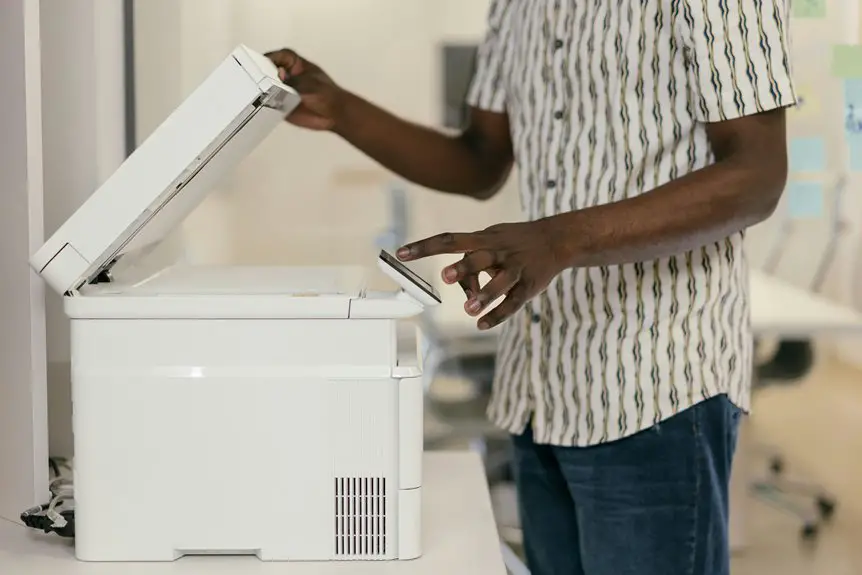Managing cables for your printer and scanner helps keep your workspace tidy and efficient. Start by assessing your cable needs, checking connection ports, and identifying the right USB or Ethernet cables. Use cable clips, ties, and sleeves for organization, while labeling each cable for easy identification. Regularly maintain your equipment and update drivers to ensure optimal performance. If you want tips on the best tools and practices for managing cables, continue exploring our guide.
Table of Contents
Key Takeaways
- Assess the required cable types (USB, Ethernet) and lengths to ensure proper connections between your printer, scanner, and computer.
- Utilize cable management tools like clips, ties, and sleeves to organize and reduce clutter in your workspace.
- Implement a labeling system for cables to easily identify their purpose and device connections, enhancing accessibility.
- Regularly check and update drivers and equipment maintenance to ensure optimal performance and compatibility with operating systems.
- Schedule bi-annual cable organization to prevent tangling, damage, and maintain a tidy workspace.
Assessing Your Cable Needs
How do you determine the right cables for your printer and scanner setup? Start by checking the connection ports on both devices. Most printers and scanners use USB, Ethernet, or wireless connections.
Check the connection ports on your printer and scanner to choose the right cables for optimal setup.
If you're using USB, note whether you need USB-A, USB-B, or USB-C cables. For Ethernet, ensure you have the correct network cable for a smooth connection.
Consider the length of the cables, too; measure the distance between your devices and your computer to avoid clutter. Don't forget to look for compatibility with your operating system; some cables may not work seamlessly with all devices.
Finally, think about any future needs—invest in cables that can adapt to upgrades or additional devices you might add later.
Choosing the Right Cable Management Tools
When it comes to managing your printer and scanner cables, the right tools can make all the difference.
You'll want to explore various cable organizers, discover the benefits of cable ties, and see how Velcro straps can simplify your setup.
Choosing the right tools will keep your workspace tidy and efficient.
Cable Organizers Overview
Choosing the right cable management tools can make a world of difference in keeping your workspace organized and efficient. You'll find various options to suit your needs, from simple clips to comprehensive storage solutions.
Here's a quick overview of some popular cable organizers:
| Type | Description | Best For |
|---|---|---|
| Cable Clips | Small clips that hold cables in place | Desk organization |
| Cable Sleeves | Fabric or plastic sleeves for bundling | Reducing tangles |
| Cable Boxes | Enclosed storage for multiple cables | Hiding clutter |
| Velcro Straps | Reusable straps for managing length | Adjustable organization |
Selecting the right tools helps streamline your setup, preventing frustration and enhancing productivity. So, take your time to explore what's best for your workspace!
Cable Ties Benefits
Cable ties offer a simple yet effective solution for keeping your printer and scanner cables neatly organized. They're durable, easy to use, and come in various sizes, making them perfect for any setup.
When you bundle your cables with ties, it not only prevents tangling but also improves your workspace's overall appearance. You can easily identify which cable belongs to which device, saving you time and frustration.
Plus, they're affordable and widely available, so you won't break the bank while organizing. Just remember to choose the right length and type for your needs, and you'll enjoy a clutter-free environment that enhances productivity.
Say goodbye to cable chaos and hello to streamlined efficiency!
Velcro Straps Usage
Velcro straps are a versatile choice for managing printer and scanner cables, providing a reusable and adjustable option that keeps your setup tidy.
They're perfect for organizing cables in various lengths and can be easily adjusted as your needs change. Here are a few reasons to consider using Velcro straps:
- Reusable: Unlike plastic ties, you can open and close Velcro straps multiple times without losing their effectiveness.
- Adjustable: You can easily resize them to accommodate different cable thicknesses, ensuring a snug fit.
- Gentle on Cables: The soft material won't damage your cables, reducing the risk of wear and tear.
Incorporating Velcro straps into your cable management strategy will enhance the organization and longevity of your setup.
Organizing Cables With Clips and Ties
While managing your workspace, organizing cables with clips and ties can significantly enhance both functionality and aesthetics. Using these simple tools, you can keep your cables tidy and easily accessible. Here's a quick overview of some effective options:
| Type of Clip/Tie | Best Use Case |
|---|---|
| Cable Clips | Securing cables to desks or walls |
| Zip Ties | Bundling multiple cables together |
| Hook-and-Loop Ties | Adjustable and reusable for various setups |
| Adhesive Clips | Mounting cables on surfaces without damage |
| Cable Management Sleeves | Grouping cables for a cleaner look |
Utilizing Cable Sleeves and Covers
Cable sleeves and covers can significantly enhance your workspace by keeping your cables organized and protected.
You'll find that choosing the right materials can't only improve aesthetics but also extend the life of your cables.
Let's explore the benefits of these solutions and how to select the best options for your needs.
Benefits of Cable Sleeves
When you want to keep your workspace tidy and organized, utilizing cable sleeves can be a game changer. These handy solutions offer several benefits that make managing your printer and scanner cables much easier.
- Reduced Clutter: Cable sleeves bundle multiple cords together, minimizing mess.
- Enhanced Safety: By keeping cables organized, you reduce tripping hazards and accidental disconnections.
- Improved Aesthetics: Sleek cable sleeves enhance your workspace's appearance, giving it a professional look.
Investing in cable sleeves not only streamlines your environment but also extends the lifespan of your cables by reducing wear and tear.
You'll find that a well-organized setup leads to increased productivity and a more enjoyable work experience.
Choosing the Right Covers
Selecting the right covers for your cables can enhance the benefits of using cable sleeves. When choosing covers, consider materials that provide durability and protection. Neoprene and nylon are great options, as they resist wear and tear while keeping your cables organized.
Next, think about the size and fit. Covers should snugly wrap around your cables without being too tight, allowing for easy installation and maintenance.
Additionally, color and design can play a role in your workspace aesthetics. Opt for covers that complement your printer and scanner setup.
Finally, ensure the covers are easy to clean and maintain. With the right cable covers, you'll not only protect your cables but also create a tidy and visually appealing workspace.
Labeling for Easy Identification
Labeling your printer and scanner cables can significantly enhance your workspace's organization and efficiency.
Enhancing your workspace's organization and efficiency starts with labeling your printer and scanner cables.
When you implement a labeling system, you'll save time and reduce frustration when troubleshooting or connecting devices.
Here are a few tips to get you started:
- Use color-coded labels for quick visual identification.
- Clearly mark each cable with the device name and purpose.
- Consider using reusable labels for easy updates as your setup changes.
Regular Maintenance and Updates
Regular maintenance and updates for your printer and scanner cables are essential for keeping your devices running smoothly and efficiently. Check your cables regularly for any signs of wear or damage, as frayed wires can lead to connectivity issues. Cleaning the connectors and ensuring they're free from dust will enhance performance.
Here's a handy table to help you keep track of maintenance tasks:
| Task | Frequency | Notes |
|---|---|---|
| Inspect cables | Monthly | Look for frays or cuts |
| Clean connectors | Bi-Monthly | Use a soft cloth |
| Update drivers | Quarterly | Check manufacturer site |
| Organize cables | Bi-Annually | Use ties or clips |
Staying on top of these tasks will extend the life of your equipment!
Frequently Asked Questions
Can I Use Wireless Connections Instead of Cables for My Printer and Scanner?
Yes, you can definitely use wireless connections instead of cables for your printer and scanner. Many modern devices support Wi-Fi, allowing you to print or scan without the hassle of tangled cords. Enjoy the freedom!
How Do I Troubleshoot Connectivity Issues With My Printer or Scanner Cables?
To troubleshoot connectivity issues, check all cable connections for tightness, inspect for damage, and ensure proper ports are used. Restart your devices, and if problems persist, try different cables or ports for better results.
What Are the Risks of Tangled Cables for My Devices?
Tangled cables can create hazards, like tripping or damaging your devices. They may also lead to connectivity issues, increased wear and tear, and difficulty in identifying which cable belongs to which device. Keep them organized!
Are There Eco-Friendly Cable Management Options Available?
Yes, there're eco-friendly cable management options available! You can use recycled materials, biodegradable ties, or fabric organizers. These choices not only reduce waste but also help you maintain a tidy, efficient workspace for your devices.
How Often Should I Replace Old or Damaged Cables?
You should replace old or damaged cables whenever you notice wear, fraying, or connectivity issues. Regularly inspect them, and if they're not functioning properly or pose safety risks, it's time for a replacement.




